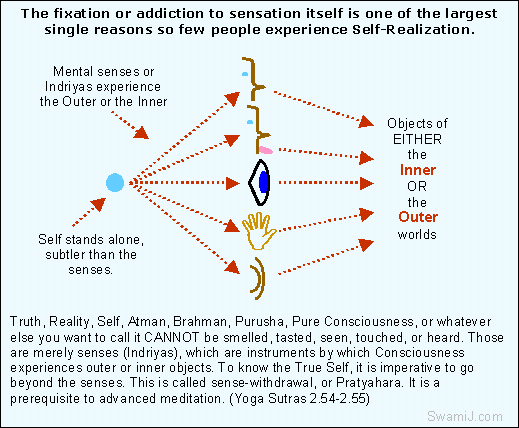|
|
Yoga
Sutras 3.7-3.8:
Internal
is Seen to be External
(Previous
Next Main)
 Skin is seen as the boundary: The skin of our body is usually seen as the boundary line between inner
and outer; the world is out there, and the aspects of me are in
here. In the beginning, it seems as if stilling the body, calming the
breath, and dealing with the senses are inner practices. Skin is seen as the boundary: The skin of our body is usually seen as the boundary line between inner
and outer; the world is out there, and the aspects of me are in
here. In the beginning, it seems as if stilling the body, calming the
breath, and dealing with the senses are inner practices.
The boundary systematically moves
inward: However, the perceptual boundary line itself moves inward
as we move along the steps of meditation. Once you move past the stilling
of the physical body and are well absorbed in awareness of the breathing
process, it starts to seem as if the body itself is external, or out
there. When attention moves further inward, beyond the breath and into
the sensory processes of the mind, both the body and breath are external,
or out there.
Body, breath, and senses are external:
Once the mind truly begins to be concentrated (dharana, 3.1), the perceptual
boundary between inner and outer has moved significantly inward. The body,
breath, and the sensory process themselves, all three, seem to be external
or out there, while we are at a doorway of the deeper realities
that now seem to be the only realities left, which are internal or in
here (3.7).
Meditation and samadhi become external:
Compared to the seedless samadhi (nirbija), the boundary line moves so far
inward that even concentration, meditation and the lower samadhis are
external (3.8).
top
3.7
These three practices of concentration (dharana), meditation (dhyana), and
samadhi are more intimate or internal than the previous five practices.
(trayam antar angam purvebhyah)
- trayam = these three
- antar = more internal,
inner, intimate
- angam = rungs, limbs,
accessories, components, steps, parts, members, constituents (2.28)
- purvebhyah = preceding,
previous
Outer awareness falls away: When
asana (postures), pranayama (breath/prana), senses (pratyahara) are seen
to be external, they have been left behind, and fall away from awareness.
This is much like the way the external world seems to vanish for us when
we are intimately involved with our body and breath awareness practices.
It is as if the body, breath, and senses no longer exist for us; we have
gone beyond them, now truly entering into the mind field. The mind field
is now perceived in a very different way, compared to the noisy, monkey
mind when earlier trying to just sit still.
Concentration, meditation, and samadhi
are intimate: When asana, pranayama, and pratyahara (body, breath,
senses) fall away, or are left behind, then concentration (dharana),
meditation (dhyana), and samadhi are seen as quite intimate or internal.
The boundary line between out there and in here has
significantly shifted; we are now ready to explore the subtler realities,
and to begin the process of setting those aside as well (vairagya,
non-attachment, 1.15-1.16), still
seeking the eternal Self at the core of our being (1.3).
top
3.8
However, these three practices are external, and not intimate compared to
nirbija samadhi, which is samadhi that has no object, nor even a seed
object on which there is concentration.
(tad api bahir angam nirbijasya)
- tad = these, they
- api = even, also,
compared to
- bahir = outer,
external
- angam = rungs, limbs,
accessories, components, steps, parts, members, constituents
- nirbijasya = seedless
samadhi, having no seed (nir = without; bijah = seed) (1.51)
Dharana, dhyana, and samadhi also
become external: The three part process of concentration, meditation,
and samadhi are practiced in relation to objects. Nirbija samadhi is seedless samadhi
(1.51), and has no object, not even
the tiniest seed of an object. From the vantage point of this seedless
samadhi, the process of samyama (dharana, dhyana, samadhi) comes to be
seen as external, just like happened in the case of the first five rungs,
as mentioned in the last sutra (3.7). Thus, eventually,
all eight rungs of the Yoga Sutras come to be seen as external practices,
when considered in relation to nirbija samadhi.

The
next sutra is 3.9
Home
Top
-------
This site is devoted to
presenting the ancient Self-Realization path of
the Tradition of the Himalayan masters in simple, understandable and
beneficial ways, while not compromising quality or depth. The goal of
our sadhana or practices is the highest
Joy that comes from the Realization in direct experience of the
center of consciousness, the Self, the Atman or Purusha, which is
one and the same with the Absolute Reality.
This Self-Realization comes through Yoga meditation of the Yoga
Sutras, the contemplative insight of Advaita Vedanta, and the
intense devotion of Samaya Sri Vidya Tantra, the three of which
complement one another like fingers on a hand.
We employ the classical approaches of Raja, Jnana, Karma, and Bhakti
Yoga, as well as Hatha, Kriya, Kundalini, Laya, Mantra, Nada, Siddha,
and Tantra Yoga. Meditation, contemplation, mantra and prayer
finally converge into a unified force directed towards the final
stage, piercing the pearl of wisdom called bindu, leading to the
Absolute.
|
|


